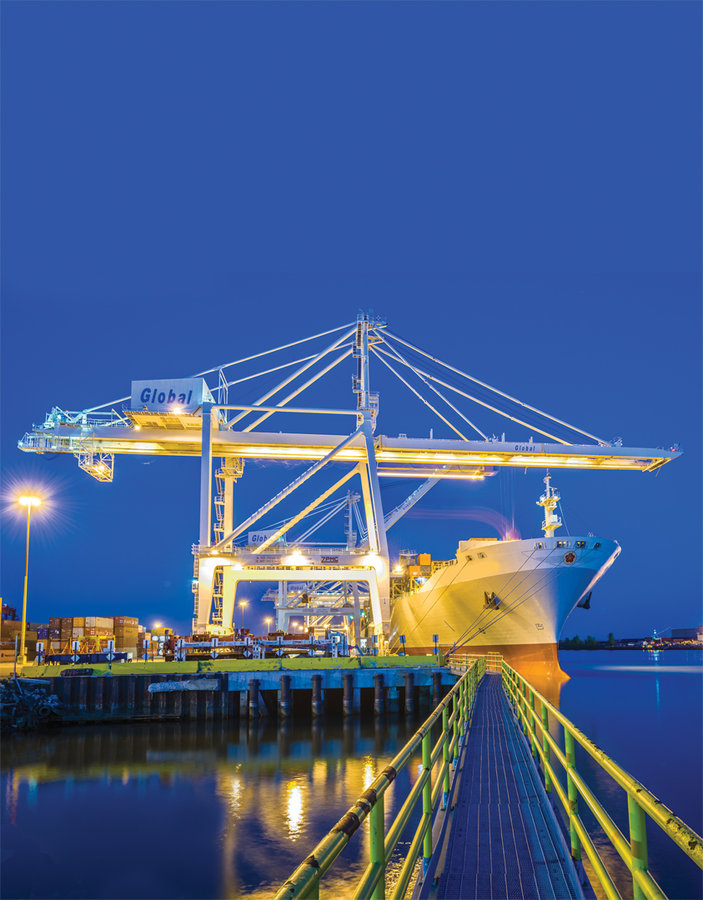When you’re buying those tank tops from T.J. Maxx, you rarely think about how they got from Malaysia to the mall. Yeah, there was that guy in the truck out back, but before that? They may have been offloaded from containers down the road a bit at GCT Bayonne. That’s the new name for what once was Global Terminal & Container Services.
In June 2014, the terminal completed a $325 million expansion that was begun in 2010 with funds from a federal grant. The 170-acre site is larger, safer, and more eco-friendly than the previous one.
GCT’s U.S. president, John Atkins, is high on the safety aspect. “We removed the people and put them in a remote location, out of harm’s way,” he says. “The best part is how we process trucks into and out of the facility. In the old operation, they lined up, came into the terminal, and stopped for inspections and paperwork.” Now, he says, “technology keeps the truck in motion at all times through the facility.”
That cuts down on idling, which cuts down on exhaust, which cuts down on pollution.
The new high-tech improvements are hard to describe in words. Fortunately, GCT has a fantastic website with three animated videos that explain the elegant and awesome technological upgrades. Visit globalterminals.com.
Expanding Industry
Folks in Bayonne are well aware of changes taking place in the shipping industry. The Bayonne Bridge roadway is being raised and the Panama Canal is being widened to accommodate modern, bigger container ships.
“The shipping industry is moving to larger, faster, more fuel-efficient ships,” Atkins says. “The larger ships are going to bring in more containers per vessel.”
GCT, a private company based in Vancouver, British Columbia, partnered with the Port Authority of New York and New Jersey. “We were able, with the Port Authority, to acquire the terminal next to us to redevelop,” says Atkins. “We paused and said wait a minute, instead of redeveloping the same old operation with the same old technology—while we have a blank canvas—why not build something really special. … We can handle more containers on a smaller footprint than under the old operation.”
Atkins says steamship lines can now gather into a consortium, using fewer large ships as opposed to six or seven lines with smaller ships.
“The import market has grown in New York and our terminal in the last few years,” Atkins says. “We serve a 30-million-person market from our area. If a line is not able to bring large vessels into New York, they would be forced to go to the nearest port, like Norfolk. Goods would be trucked or railed to New York. All that extra handling increases the cost. The largest vessels keep costs down for everyone.”
Bayonne Friendly
Most folks know that we have a large shipping presence here in Bayonne. If nothing else, you can see the terminal’s huge cranes for miles around. But most of us are pretty vague about the details. For one thing, the average Joe can’t just walk onto the premises. It’s a bonded industrial facility protected by Customs and the Coast Guard (See story on Page 42), so there are security issues.
“For now, we are governed by regulations,” Atkins says, “but down the road it is not out of the realm of possibility that we would have a Community Day.”
But GCT already does interact with the community. “We employ many Hudson County residents,” Atkins says, “particularly from Bayonne. We use local vendors and local purchasing as much as possible. We have several initiatives that give back to the community.”
The company supports the local Meals on Wheels and worked with the city to buy a fire truck when it did not receive funding.
“We’re mindful of the area around us,” Atkins says, referencing the construction at Exit 14 of the New Jersey Turnpike, which should ease traffic in the vicinity. The company was also looking to fund an environmental protection effort that would benefit our local wetlands. Various Department of Environmental Protection strictures precluded such a project on the acres contiguous to the facility, so GCT created tidal wetlands and preserved uplands on a 16.1-acre site adjacent to the Hackensack River to benefit local marsh species. Native vegetation was also planted to preserve the environment for local fish and wildlife.
Getting the Goods
While GCT itself has ties to the community, Atkins refers to shipping as a “stealth industry,” meaning that folks aren’t aware of how merchandise arrives in our country.
The huge West Coast ports of Los Angeles and Long Beach offload goods which are then railed to the Midwest and sometimes all the way to the East Coast, according to Atkins. Singapore, Shanghai, and Hong Kong are the big Asian ports. Goods are loaded from there onto large vessels headed for Europe and the U.S.
In a small way, Atkins is doing his part on the education front. He has three young kids, and when they get a toy, a book, or a game, their dad always asks them to find out where the item was manufactured.
“So much of what we consume every day has to come from overseas,” Atkins says. “It’s a quiet industry. People aren’t aware of what’s done and how.”—Kate Rounds
Photos by Nick Souza
